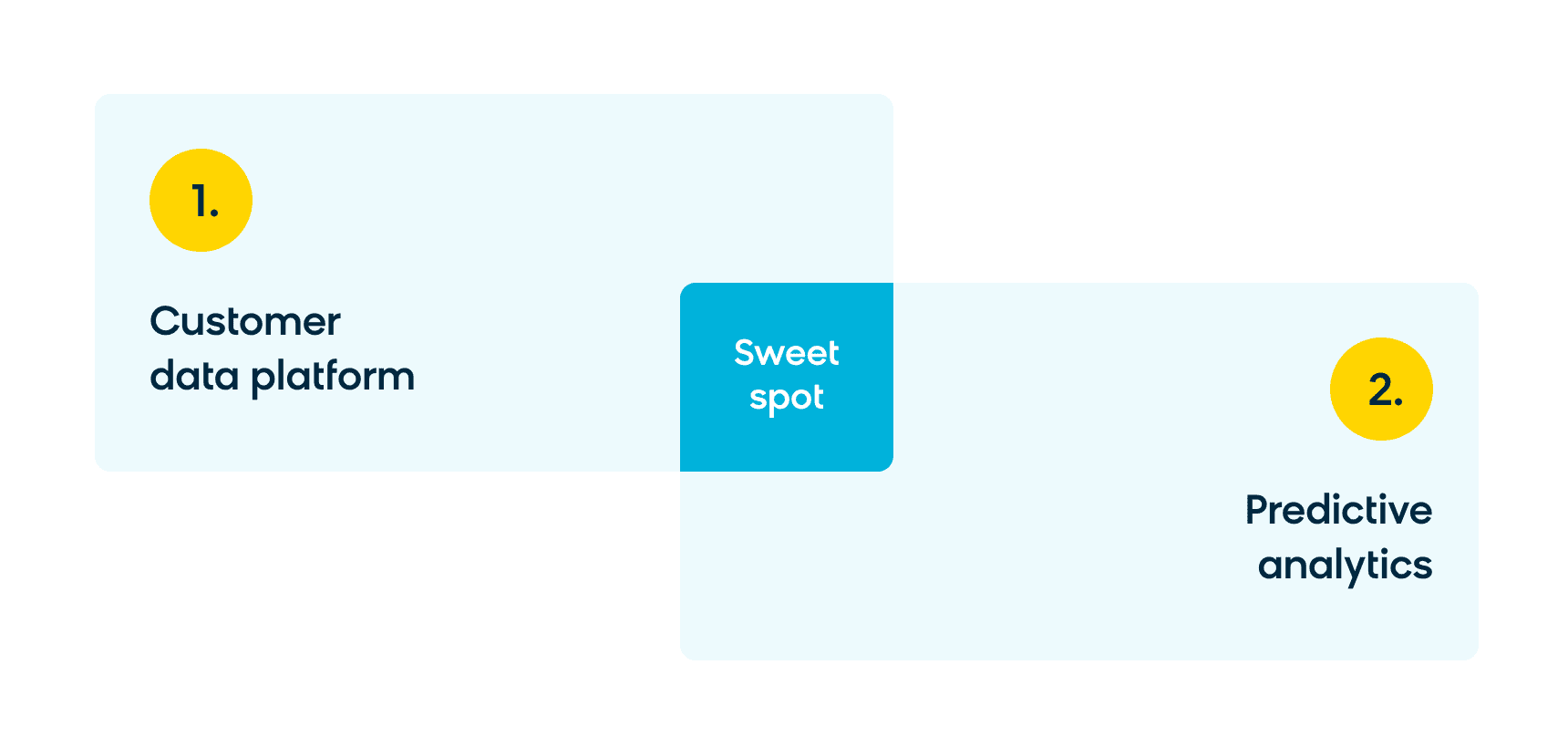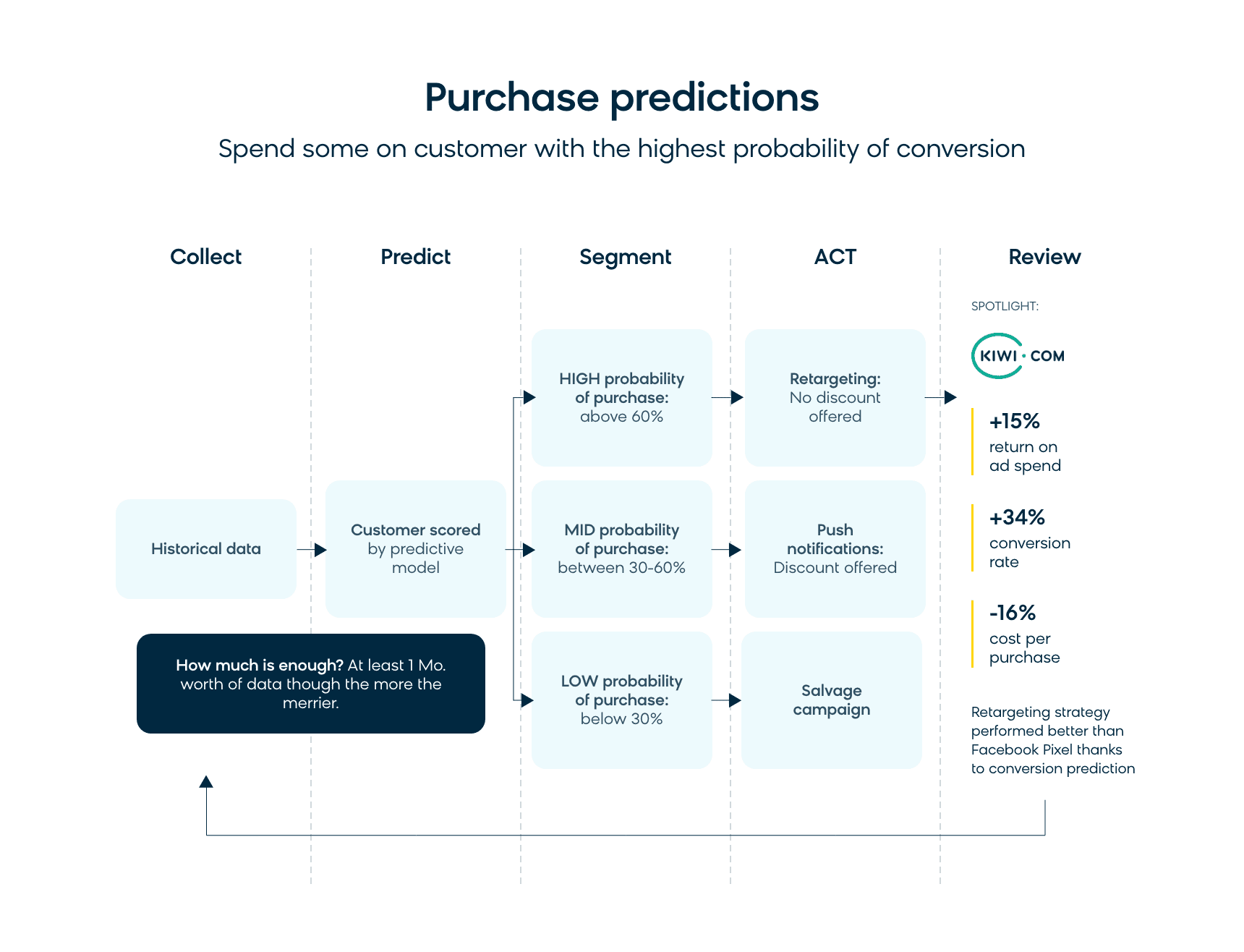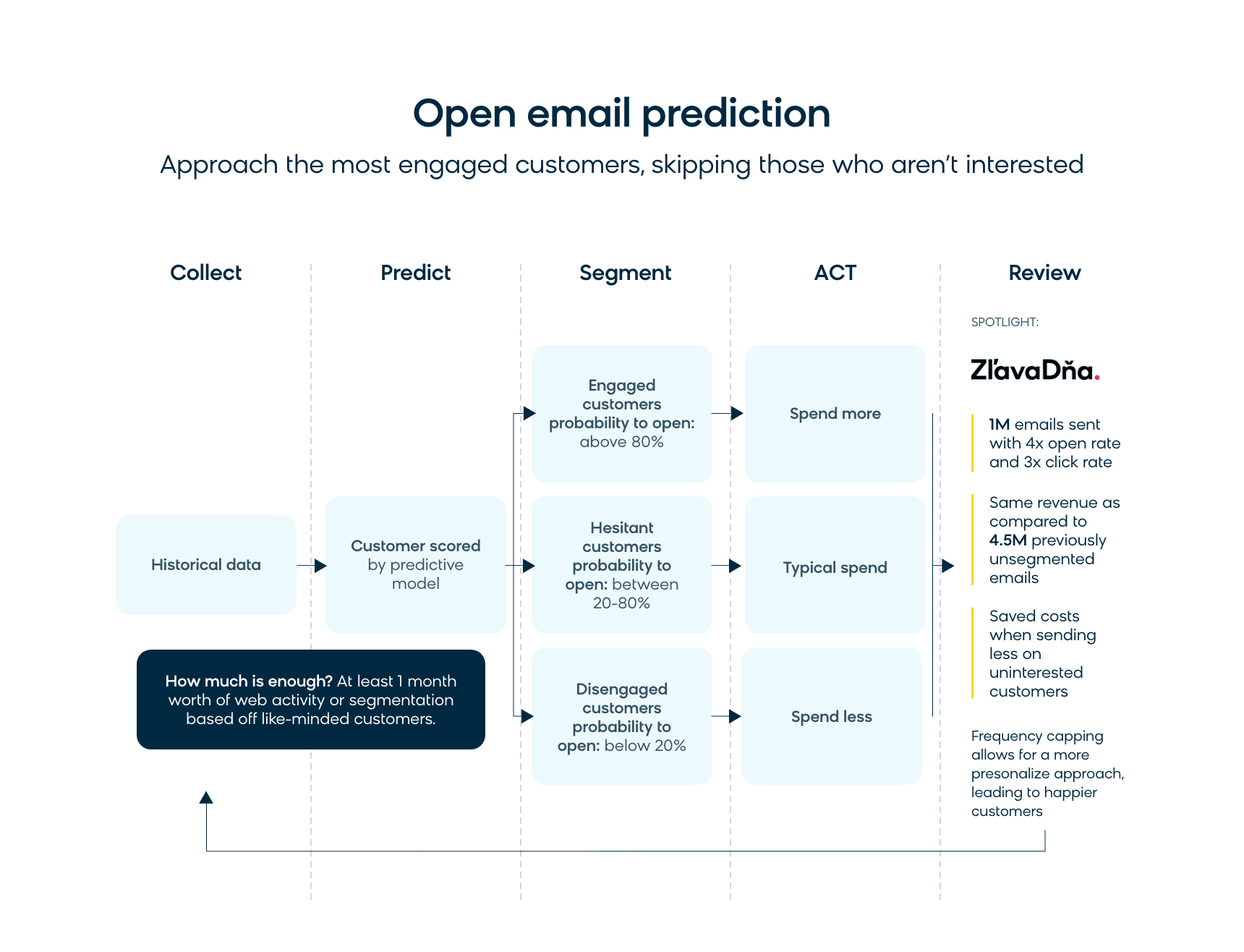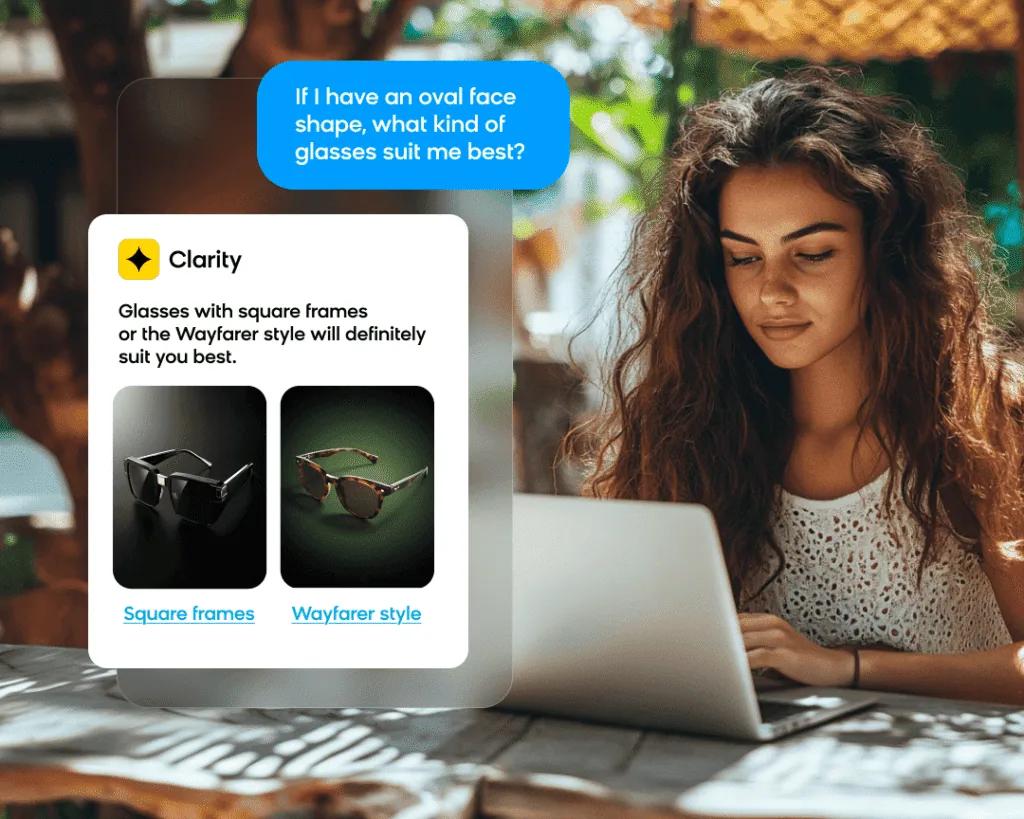Predicting your customers’ next steps is no longer a novel tactic. In fact, predictive marketing is more popular and more possible than ever before.
In today’s data-driven world, customer data has become a goldmine for businesses looking to gain a competitive edge. By harnessing the power of predictive analytics tools and software, brands can unlock valuable insights into customer behavior, preferences, and buying patterns. This wealth of information forms the foundation of an effective predictive marketing strategy.
At the core of predictive marketing lies the ability to leverage customer data and transform it into actionable insights. With the help of advanced predictive analytics tools and software, businesses can mine vast amounts of customer data, including browsing history, purchase behavior, demographics, and interactions with the brand. By analyzing this data, patterns and trends can be identified, enabling businesses to make informed decisions about their marketing strategies.
Predictive analytics tools play a crucial role in predictive marketing by utilizing algorithms and statistical models to predict future customer behavior. These tools take into account various factors such as past purchase history, website engagement, and social media interactions to generate accurate forecasts. Armed with these predictions, businesses can tailor their marketing messages to resonate with specific customer segments, increasing the likelihood of conversions and customer satisfaction.
A well-executed predictive marketing strategy can transform a marketing campaign into a highly personalized and targeted experience. By leveraging predictive analytics software, businesses can segment their audience based on specific criteria such as interests, demographics, and buying behavior. This enables them to craft customized messages that speak directly to the needs and preferences of each segment, driving engagement and loyalty.
The benefits of predictive marketing extend beyond personalized messaging. By using predictive analytics tools, businesses can also optimize their marketing budgets and resources. By identifying high-value customer segments and predicting their response to different marketing tactics, companies can allocate their resources more efficiently, maximizing the return on investment for each campaign.
To implement a successful predictive marketing strategy, it is crucial to choose the right predictive marketing software. These software solutions provide the infrastructure and tools necessary to analyze and interpret customer data effectively. They offer features such as data visualization, predictive modeling, and automated campaign execution, enabling businesses to streamline their marketing efforts and drive better results.
We’ve put together a list of our favorite predictive analytics-based use cases, and described them below. Why are these our favorites? Because they work consistently, and many can be employed immediately, so long as the company’s data is ready to be put to work.
Check out the use cases below and what you’ll need to deploy them, and get ready to look to the future.
What is Predictive Marketing?
Machine learning, artificial intelligence, big data science — whichever term you wish to use, predictive marketing is the new frontier for ecommerce marketers big and small.
Predictive marketing is defined as a marketing technique that utilizes predictive analytics to determine which marketing strategies and actions have the highest probability to succeed or fail.
So instead of flying blind with marketing campaigns, marketers can leverage their vast amounts of data to identify patterns and anticipate future customer behaviors, sales trends and marketing outcomes.
How Predictive Marketing Works
Predictive Marketing uses data science to collect vast amounts of information and predictive analytics in order to scientifically guide marketers to the best marketing action. The core analytic principle is that by analyzing past historical data, we can predict future activity – very similar to temperature forecasting. So instead of guessing what the temperature will be tomorrow, science uses a mix of historic and current data to predict in an accurate manner.
Benefits of Predictive Marketing
While gathering customer data to improve future marketing efforts is not a new practice, modern strategies use machine learning and artificial intelligence algorithms to process previously unimaginable volumes of information.
Marketers can take advantage of their customer profiles to develop predictive models, identify more profitable leads, and analyze program performance. In addition, organizations that use predictive strategies have more opportunities to appeal to their desired audience, creating personalized, actionable responses to any predicted situation.
Most importantly, it’s now flexible to use in various business scenarios, accessible to marketers and easy-to-implement.
Artificial Intelligence and Predictive Marketing
When combined with predictive analytics, artificial intelligence (AI) becomes a powerful tool that can transform how businesses understand and engage with their customers. AI in predictive marketing is reshaping the landscape of modern marketing strategies.
Predictive marketing leverages AI algorithms and machine learning techniques to analyze vast amounts of customer data. By processing historical data, AI models learn patterns and trends, enabling businesses to predict future customer behavior and preferences. This predictive analysis allows marketers to tailor their strategies and messages to meet the specific needs and interests of individual customers or customer segments.
One of the key advantages of AI in predictive marketing is its ability to deliver highly personalized experiences. By understanding customer behavior and preferences, AI-powered systems can recommend relevant products or services and create targeted messaging that resonates with each customer. This level of ecommerce personalization goes beyond simple segmentation and enables businesses to build stronger relationships with their customers.
AI also plays a crucial role in optimizing marketing campaigns. Predictive analytics powered by AI can identify the most effective channels, timing, and content for reaching target audiences. By analyzing data from various sources, including social media, website interactions, and purchase history, AI algorithms can determine the best marketing strategies to maximize engagement and conversions.
AI-driven predictive marketing enables businesses to anticipate customer needs and proactively address them. By analyzing past behavior, AI algorithms can identify potential buying signals and trigger personalized marketing actions in real-time. This proactive approach allows businesses to stay one step ahead of their customers, providing them with relevant information and offers when they need them the most.
It’s important to note that while AI and predictive analytics work hand-in-hand, they are not the same. AI refers to the broader concept of machines exhibiting human-like intelligence, while predictive analytics focuses specifically on using data to forecast future outcomes. AI provides the foundation for predictive analytics, enabling businesses to leverage its capabilities to gain valuable insights and make data-driven marketing decisions.
As technology continues to evolve, AI-powered predictive marketing is poised to revolutionize the way businesses connect with their customers and drive business growth.
Challenges of Predictive Marketing
Predictive marketing acts as a well-oiled machine. Siloed data, varying insights, and delayed reporting all act as roadblocks, preventing access to key insights for more efficient resource spend for sales and marketing departments.
The point is to create more opportunities to put a tailored message in front of an interested audience, and for that you’ll need the right tools for the job.
The Killer Combination
The approach to a more competitive data strategy is simple:
Marketers do their best to deliver a personalized customer experience, but they often get lost among the different technological solutions available and even worse, data gets fragmented across their marketing stack.
Thanks to the unique combination of a customer data platform (CDP) and real-time predictive analytics, we’re able to unpack this powerful duo to unleash predictive marketing techniques that deliver results.
The Customer Data Platform
In a world filled with technology, and increasing complexities, it’s easy to forget about the people actually making the purchasing decisions.
Customer data platforms gather and organize information about these customers, giving retailers the chance to turn that data into ideal shopping experiences.
The software integrates with your company’s customer data to un-silo, identify, merge and reorganize it, directing all communication channels to a central data hub.
David Raab, founder and principal of Raab & Associates, built a five-point checklist to identify a customer data platform.
Predictive Analytics
The use of algorithms to predict the likelihood of an event occurring in the future (e.g. a customer’s likelihood of a second purchase).
It’s rather powerful, too.
When discussing the impact of predictions on organizational performance, Forbes concluded, “predictive marketers are 1.8x more likely to consistently exceed shared organizational goals, and 2.9x more likely to report revenue growth at rates higher than the industry average.”
In essence, predictive analytics:
- Promotes timeliness by predicting your customer’s next move.
- Uncovers knowledge by scoring customers based off event possibilities.
- Improves marketing automation by segmenting communication with customer scores.
- Enhances the competitive edge by becoming a well-oiled machine.
This is the predictive analytics norm, and it’s highly effective. But you’ll need to dig deeper if you want to build a full customer profile and deliver a more relevant marketing experience: it’s all about the unique blend of the two.
The Unique Combination
Imagine the alternative, where a holistic approach to customer data is underutilized or unavailable. Information feeding the analytical models are incomplete and limited to whatever siloed data is temporary unlocked. The resulting predictions wouldn’t pass as accurate, leaving core decisions being made from shaky analytical foundations.
For some this is a reality—but it doesn’t need to be.
Combining a CDP with predictive analytics forms an exceptional superpower. When done right, we’re able to create an online experience that truly resonates with your target customer.
Most importantly, a prediction-powered CDP can unlock your marketing capability that’s currently sitting dormant.
Check out these use cases and start creating ‘sweet spots’ for your brand.
Predictive Marketing Use Cases
Anyone trying to sell a one-size-fits-all predictive marketing solution is a warning sign for snake oil software. The very premise of predictive modeling is that the model is tailor made for a specific data set and specific goal in mind.
Thus, these solutions are exceedingly flexible and can be capitalized by the unique nature of your customer, company or industry.
And to carry the essence of how custom predictive marketing can be, many of these individual predictive analytic solutions can be interrelated as well, often acting as a combined force to tackle difficult challenges.
Consider for instance: delivering a message to the right customer (open email prediction), at the right place (preferred channel prediction), at the right time (optimal email time prediction).
Purchase Predictions
What is a Purchase Prediction?
We use predictive analytics to analyze precursors to determine whether a purchase will happen with a given customer. This information is provided as a score, which can be used to segment communication; a deciding factor when considering which customer is worth further marketing and sales investment.
You wouldn’t send a promotional offer to a customer that will make the purchase anyway, while others need a promotional nudge from inbound marketing to convert.
Purchase prediction is one of the strongest use-cases for predictive analytics. The model takes into consideration multiple customer-specific variables (age, time between the first and last purchase, purchase frequency, etc.) to make a prediction.
The bare minimum is one month worth of customer data, though the more information that’s available, the more precise the prediction will be.
In the example below, online travel agency Kiwi.com wanted to start segmenting their communication with the use of predictive analytics.
When communicating to the various segmented customers, each strategy was different:
- With a high probability of purchase, customers were retargeted to help finish their purchase.
- Medium probability received web push notifications, offering a discount in hopes of converting into a sale.
- While a low probability had its own low-cost campaign in place, in an effort to salvage those uninterested in a purchase.
When communicating to the various segmented customers, each strategy was different:
- With a high probability of purchase, customers were retargeted to help finish their purchase.
- Medium probability received web push notifications, offering a discount in hopes of converting into a sale.
- While a low probability had its own low-cost campaign in place, in an effort to salvage those uninterested in a purchase.
Why segment at all?
Where the click-through rate (CTR) of a retargeted ad is 10x higher than the CTR of a typical display ad, we can take it a step further by using predictive analytics to improve this average.
If we only remarket to customers who we predicted will most likely revisit the website, purchase again, or submit their details, we can save on ad costs while getting higher conversions.
Open Email Prediction
What is Open Email Prediction?
For some brands, email is the most essential channel for customer communication.
Where the average value of an email address in your database is £84.50, why not take proactive steps to ensure that customers are kept engaged, and the integrity of your email database is secure?
Open email predictions uncovers whether or not a customer will open your next email.
Armed with this knowledge, brands can atone the frequency of their email communication, reducing the likelihood of an unsubscribe or an email ending up in spam — a damaging result for any brand.
When predicting the likelihood of a customer opening an email campaign, the aim is to approach the most engaged customers first, skipping those uninterested.
In the use case below, we challenged ZlavaDna, a CEE-based coupon platform, with a simple hypothesis: Do we really need to send a newsletter to everyone? What if we only approach the most engaged customers?
With the use of predictive analytics, customers were scored based on data found in their profile, assembled by the CDP, including previous open rates, recent web activity and the comparison of other like-minded customers.
The score is then used to produce segmentation, where frequency capping is introduced, limiting the amount of communication that’s allowed for each segment.
ZlavaDna targeted the 20% of customers with the highest likelihood of opening their emails in an attempt to minimize the amount of customers targeted, while maximizing the impact of each email sent.
Take a look at the results:
To sum it up, ZlavaDna was able to send 1 million emails with an almost 4x higher open rate and a 3x higher click-through rate, resulting in the same revenue as opposed to sending 4.5 million emails.
They found their sweet-spot success by addressing customers as individuals, considering their preferences when fine-tuning email frequency.
As an added bonus, the client was able to save by sending fewer redundant emails.
Optimal Email Time Prediction
What is Optimal Email Time Prediction?
Where open email predictions improves frequency, optimal email time prediction aims to identify the exact time that an email should hit the inbox.
It’s crucial, since customer preferences widely vary. Some are more inclined to open and read an email newsletter in the morning, or just outside of work hours, and others filter through retail emails over lunch.
By knowing the precise time an email should be deployed, marketers can hope to achieve:
- Leveraging otherwise untapped big data.
- Automate email dispatching without user intervention.
- Increase open and click-through-rates.
All it takes is an initial customer event to occur, called a session start, or one opened email to begin to understand a preferred communication time. We’re all creatures of habit, so any additional sessions or opened emails will narrow down this time frame to the perfect one.
With Missguided the hypothesis was very simple: When should we send our newsletters to ensure they’ll be read?
This time, instead of a score, each customer is assigned an optimal email time and segmented in order to automize communication. Here’s how it all went down:
With a sample size of about 100,000 customers, there were no surprises when the results came in. Predicting an optimal email time ultimately improved the clickthrough rates by +12%, which could even be seen as a +13% uptick on revenue.
So instead of endlessly searching the web for a real answer to the question, “When is the best time to send an email?” Missguided took it a step further with predictive marketing to personalize the email send individually with each and every customer.
Further Reading: We’ve put together a comprehensive guide on email deliverability to help you get your emails to the inbox.
Battling Customer Churn
What’s Churn Prediction?
The aim of churn prediction is to catch straying customers as early as possible, giving them incentives to re-engage before it’s too late.
Since only about one out of 26 unhappy customers complain, the rest of the 96% churn silently.
It’s time to ask yourself, “Are we losing customers? If so, how?”
As AMEX’s Marketing Development Manager for Global Corporate Payments, Simon Taranto, recalled, “the customer team didn’t know why these people would churn – we didn’t have any insights, only hunches as to why those customers didn’t work out.”
Thousands of companies find themselves in a similar situation, since customers tend to break the relationship sooner or later, it’s best to keep informed in an attempt to stop it from reoccurring. Those who unsubscribe, grow cold, or turn to a competitor are lost opportunities.
Though there’s hope for a better outcome.
Predictive analytics can highlight those who are most likely to churn, providing room for early action. Through the minimization of attrition, we find the importance for maximum customer retention and grow our customer lifetime value (CLV).
The objective is simple: identify the customers likely to churn with the aim to retain them and thereby increase overall conversions and revenues over time.
All it takes is at least 180 days worth of customer data, including sessions or login events, to fully comprehend the situation at hand. Armed with enough information, customers are scored and segmented off their likelihood to churn.
Actions can then be introduced to plug the leak in the customer bucket, including tailored messages, selective discounts, or improving steps in the buyer journey.
Here’s what proactive churn prediction looks like:
By identifying key next-likely-actions, marketers are not only empowered with the knowledge of churn likelihood, but obtain the opportunity to influence the outcome. Thus, by targeting high vs low propensity segments with personalized messages, brands can eliminate blast campaigns, achieving similar or better results while saving time and money.
In-Session Prediction
What is an In-Session Prediction?
Excited customers who are impending conversion, tend to follow similar behavioral patterns. By identifying those that are ready, marketers can help them finish their session with an incentive to purchase.
Incentives can come in all shapes and sizes, however some of the most effective now come as a web layer, advertising a one-time promotional deal that doesn’t aggravate the customer, though effectively communicates promotional value.
Real-World Example:
With little over 1,000 customers a month, brands can unlock behavioral insights that can boost in-session results and promote web page personalization.
So how do you choose which banner is the best to show?
Historical data is leveraged to score and segment customers. This segmentation can then be used to automate tailored incentives that push each customer to purchase.
With a high propensity to purchase, discounts are not required since a purchase is likely on the horizon. However, free-shipping as well as up- and cross-sale opportunities can be presented with an added sense of urgency with the implementation of a simple countdown timer.
Let’s take a look at how this would work:
Use Bloomreach to Drive Your Predictive Marketing Strategy
Based on these advantages, there’s really no question at all: employing predictive marketing techniques will help you maximize your marketing objectives, and increase your sales potential.
If you’re looking to improve your predictive marketing, data analytics, or begin tapping into new marketing channels to better connect with your customers, Bloomreach Engagement is the all-in-one solution you need to do just that. If your ecommerce company is having trouble turning data points into personalized marketing campaigns, explore our use case library for inspiration.
You can also explore our predictive marketing and analytics page to learn more.



















